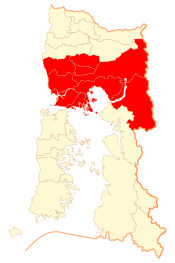
Los Lagos Region is one of Chile's 16 regions, which are first order administrative divisions, and comprises four provinces: Chiloé, Llanquihue, Osorno and Palena. The region contains the country's second largest island, Chiloé, and the second largest lake, Llanquihue. Its capital is Puerto Montt; other important cities include Osorno, Castro, Ancud, and Puerto Varas. The mainland portion of Los Lagos Region south of Reloncaví Sound is considered part of Patagonia.

Puerto Montt is a port city and commune in southern Chile, located at the northern end of the Reloncaví Sound in the Llanquihue Province, Los Lagos Region, 1,055 km to the south of the capital, Santiago. The commune spans an area of 1,673 km2 (646 sq mi) and has a population of 245,902 in 2017. It is bounded by the communes of Puerto Varas to the north, Cochamó to the east and southeast, Calbuco to the southwest and Maullín and Los Muermos to the west.

Frutillar is a city and commune located in southern Chile, Chilean Patagonia, in Llanquihue Province, within the Los Lagos Region, the lake district. The bay of Frutillar is placed on the banks of Lake Llanquihue, the largest lake entirely within Chile. Frutillar is known as the "City of Music", and since 2017 is part of the UNESCO Creative Cities Network (UCCN), becoming the first Chilean city to be nominated, as well as the southernmost Creative City of Music in the world.

Puerto Varas, also known as "La ciudad de las rosas" or “the city of roses”, is a city and commune located in the southern Chilean province of Llanquihue, in the Los Lagos Region.
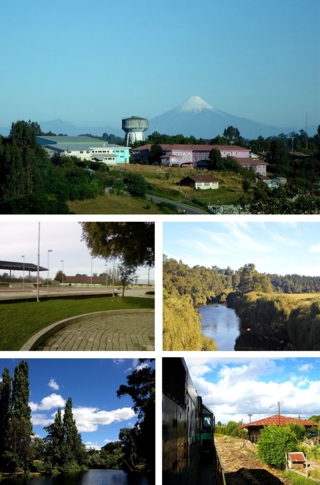
Río Negro is a Chilean city and commune in Osorno Province, Los Lagos Region. The city is located 38 km south of Osorno and 6 km west of Route 5. It has an area of 1,266 km² and a population of 14,732 inhabitants.
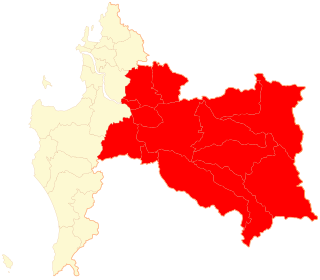
Biobío Province is one of three provinces of the Chilean region of Biobío (VIII). Its capital is Los Ángeles. It is bounded on the north, west and south by the provinces of Concepción, Arauco and Malleco, respectively, and on the east by Argentina. It has an area of 14,987.9 km2 (5,787 sq mi) of well-wooded and mountainous country, and exports timber to a large extent. The population is 373,981 according to the census of 2012.

Calbuco is a stratovolcano in southern Chile, located southeast of Llanquihue Lake and northwest of Chapo Lake, in the Los Lagos Region, and close to the cities of Puerto Varas and Puerto Montt. With an elevation of 2,015 meters above sea level, the volcano and the surrounding area are protected within the Llanquihue National Reserve.
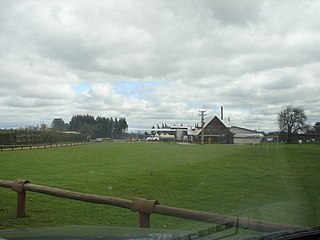
Purranque is a city in the Chilean Los Lagos Region, which lies on the Pan-American Highway about 65 km (40 mi) north of Puerto Montt. It is part of the Osorno Province.
Fresia is a city and commune in Llanquihue Province, Los Lagos Region, Chile.

The Archdiocese of Puerto Montt is a Metropolitan See of the Roman Catholic church, in Chile. Its suffragan dioceses are: Osorno, San Carlos de Ancud and Punta Arenas.
Puerto Octay is a town and commune in Osorno Province located on the north shore of Llanquihue Lake in Los Lagos Region in the south of Chile. It was settled by German colonists in 1852. Puerto Octay was an important port with regular traffic to Puerto Varas before the railway opened in 1912.

Chapo Lake is a lake of Chile located in Los Lagos Region. It lies immediately southeast of Calbuco volcano and south of Llanquihue National Reserve. Just south of the lake is Alerce Andino National Park.
Puyehue is a commune in Chile located in Osorno Province of Los Lagos Region. It is bordered to the south by Rupanco Lake, to the east by the Andes and Argentina, to the north by Puyehue Lake and to the west by Osorno commune. Cardenal Antonio Samoré Pass that links the Los Lagos Region to Argentina lies in the eastern tip of the commune. The comune is administered by Entre Lagos, the main town in Puyehue.
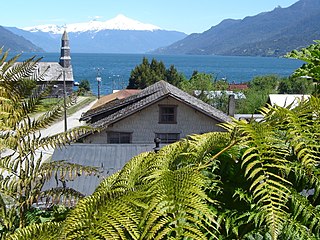
Cochamó is a Chilean town and commune located in Llanquihue Province, Los Lagos Region. The capital of the commune is the town of Río Puelo, which is named after the Puelo River.

Calbuco is a city and commune in southern Chile administered by the Municipality of Calbuco. Administratively Calbuco belongs to the Llanquihue Province of Los Lagos Region. The origin of the city was the Spanish Fort Calbuco founded in 1603, and became later an important fish market. The archaeological site of Monte Verde lies within the commune.

Maullín is Chilean town and commune in Llanquihue Province which is part of Los Lagos Region. The commune is located in at the outflow of Maullín River.

Llanquihue is a Chilean commune and city in Llanquihue Province, Los Lagos Region. The city lies on the western shore of Lake Llanquihue, where the Maullín River starts. It is located 7 kilometres (4.3 mi) north of Puerto Varas and 19 kilometres (12 mi) south of Frutillar and is connected to both cities by Chile Highway 5.
Los Muermos is a city and commune in Llanquihue Province, Los Lagos Region in southern Chile.
Calbuco is a city and commune in Llanquihue Province, Chile.

The Lutheran Church in Chile is one of the two denominations of Lutheranism in Chile. It separated from the historical Evangelical Lutheran Church in Chile (IELCH) in 1975 due to differences in political perceptions of the pastors and bishops during the beginning of the military dictatorship led by Augusto Pinochet. It is a member of the Lutheran World Federation, which it joined in 1991. Most congregations are bilingual in German and Spanish.

